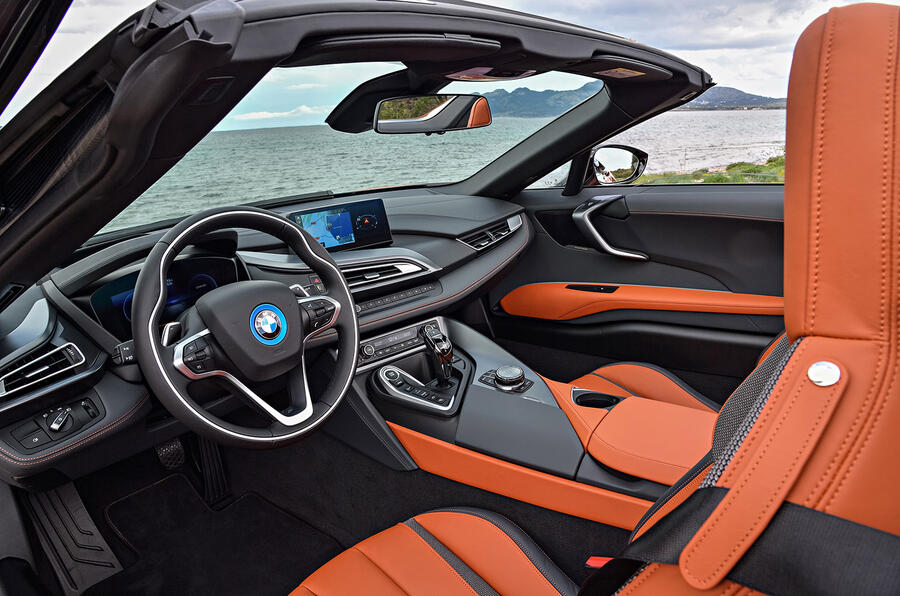To accommodate the new soft top, BMW has modified the windscreen of the i8, providing it with a strengthened carbonfibre frame. The rear window, which doubles as a wind deflector, is also altered and can be closed or opened independently of the roof.
Further stylistic changes over the facelifted i8 Coupé that's set for UK delivery at the same time in June include the deletion of the rear side windows. They are replaced by new panels overlaid with aluminium-look trims with the word 'Roadster' on the side of the new buttresses.
In combination with further strengthening measures within the carbonfibre-reinforced plastic and aluminium structure and new frameless scissor-action doors, weight has increased by 60kg over the facelifted coupé at 1595kg.
Inside, the two-plus-two configuration of the fixed-roof i8 has given way to a two-seat layout, with the rear of the cabin altered to provide 92 litres of oddment space within three separate cubby holes in the rear bulkhead. It combines with the 88 litres of the rear-mounted luggage area to provide an overall 160 litres of stowage space.
The earlier dashboard design has also been lightly updated for the i8 Roadster and facelifted i8 Coupé. Among other subtle changes, the latest version of BMW’s iDrive system now offers either touch control on a free-standing 8.8in monitor or via a rotary dial on the middle console.
There are also new seats, an optional head-up display unit as well a range of new trim options, including carbonfibre trim elements for the dashboard and ceramic controls within the centre console.
One key change in the powertrain is an increase in output from the front-mounted electric motor. The unit, which was produced in-house, now delivers 12bhp more than it did in the earlier i8 Coupé at 141bhp. This is delivered along with the same 184lb ft as before, through a two-speed gearbox to the front wheels.
Combined with the unchanged 228bhp delivered by the turbocharged 1.5-litre three-cylinder petrol engine mounted transversely up back in a mid-rear position, this provides the roadster with an overall 374bhp and a theoretical maximum torque loading of 420lb ft, although the latter is continually regulated depending on grip and traction levels, with drive delivered to the rear wheels via a six-speed torque converter-equipped automatic gearbox.
Further modifications have also been made to the lithium-ion battery, which is mounted wholly within the centre tunnel. While similarly dimensioned to the unit used previously, its cell capacity has been raised from 20Ah to 34Ah. The use of fourth-generation cells have also increased its energy capacity from an earlier 7.1kWh to 11.6kWh. As a result, BMW quotes a pure-electric range for the i8 Roadster of 33 miles - some 10 miles more than it quoted for the earlier i8 Coupé.
As well as recuperating energy under braking, the roadster uses the same electric motor at the rear as the i8 Coupé. It acts as a generator to top up the battery on the overrun. Around town in eDrive Eco mode, progress is whisper quiet and quite urgent as the upgraded electric motor provides drive exclusively to the front wheels. But with a turning circle of 12.3 metres overall, manoeuvrability in tight urban conditions certainly isn’t one of this car’s biggest strengths.
But don’t let anyone tell you the i8 Roadster is lacking speed. There are quicker cars at this price point, granted. But the combination of electric and petrol power in Hybrid Drive Sport mode provides the car with both brutish four-wheel drive accelerative qualities off the line and great long distance touring traits on the open road. There is excellent flexibility across a broad range and, once you’ve wound on sufficient revs, there's a stirring engine note, too.
Despite changes to the suspension bushings and a new vertical strut for improved wheel control at the rear, there remains some annoying tyre roar on less-than-smooth surfaces. However, the secondary vibrations through the carbonfibre body structure, both from the road and engine, are now much better damped than with the earlier i8 Coupé in a move that helps improve overall refinement.
Further improvements have been focused at the steering. It receives new mapping, which brings greater sensitivity around the straight ahead. It’s still quite light by sports car standards, but there’s now added weight off-centre. Overall, it endows the i8 Roadster with a more responsive feel than the i8 Coupé, allowing you to place the car more confidently in corners and indulge in its excellent dynamic capabilities.

Comments
Post a Comment